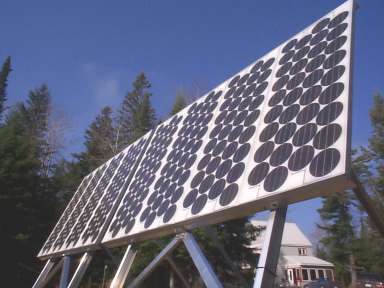Home/office renewable energy
A case study
System performance

Home/office renewable energyA case studySystem performance |

|
|
How does the system perform? Short answer: just great. Since the wind turbine was installed in the fall of 2004, we've been virtually independent of the electrical grid. We love living with renewables. We like the process of budgeting electricity and planning our usage around periods of sun and/or wind. We like the linkage between our heat and power consumption and the weather and the seasons. When the system is down for periodic maintenance and we are forced to connect to the electrical grid, we feel like something important is missing from our lives. |
|
Along the way, though, there have been periods of
anguish, both financial and emotional. There have been breakdowns, some
of which have been a little scary and a lot expensive. Here is a short
list of glitches we've experienced:
The real star performer of our system is the wind turbine, which produces power with remarkable consistency. Of course, it was the most expensive component, but I am not so sure that an equivalent investment in solar panels would produce the same consistent electricity production. We've noticed that the wind and solar systems complement each other to provide a flow of power that meets our needs. One concern frequently mentioned about wind turbines is noise, but we have not found noise to be a problem at all. The turbine's designer, Hugh Piggott, claims that his low speed design is superior because it starts up at low wind speeds, produces useable power at low wind speeds and is a lot quieter than high rpm turbines, which most others are. Our experience confirms all three claims. The turbine is virtually silent until it gets close to furling in high winds. At that point you can hear a fluttering sound like helicopter blades. The flutter is hardly louder than the sound of wind in the trees. Our turbine is about as close to the house as you'd want such a structure and we have never, under any conditions, heard the turbine inside the house. At this point (September '05), we haven't had the whole system functioning for a full year yet, so maybe the wind will stop for a week or two and clouds will obscure the sun and cause me to eat my words. But so far, wind or sun seems to come along just as I'm thinking I'll need to connect to the grid to charge the batteries. I'm sure that every site and every system is different, so our experience may not serve as reliable guidance for others. I am not one of those who claims that moving to renewable energy is easy and that anyone can do it in their spare time. Maybe we're unusual, but we've found this to be a challenging process, even though we started with fairly good skills and knowledge. I've noticed that average people who may have an interest but haven't started building their own renewable energy system underestimate the cost and effort involved. I've also noticed that people writing articles about household renewable energy tend to feed this misconception by making it all sound so simple and straightforward. I don't mean to dissuade people from making the move to renewables, but I am suggesting that it is not an easy process, especially for people who aren't handy with tools and comfortable with a dizzying array of technologies. Having heated with wood for decades, I've developed a sense of what energy means in terms of cost and impact. Knowing how long a tree takes to grow and after handling each piece of firewood several times before burning it, one begins to appreciate the amount of power and convenience that is imbedded in a gallon of fuel oil, a cubic metre of natural gas or a kilowatt hour of grid electricity. Our experience shows clearly that the replacement of fossil fuels with renewables is costly and difficult for a single household. I wonder if it is possible for a community or a country to make such a transition. |